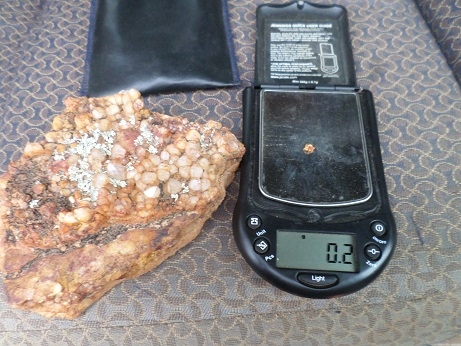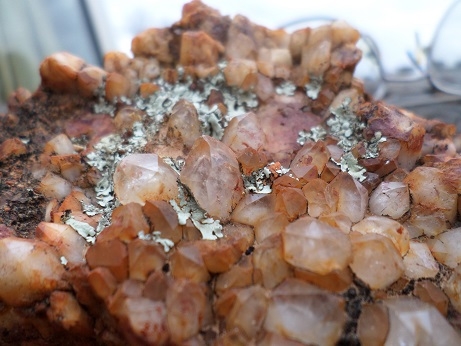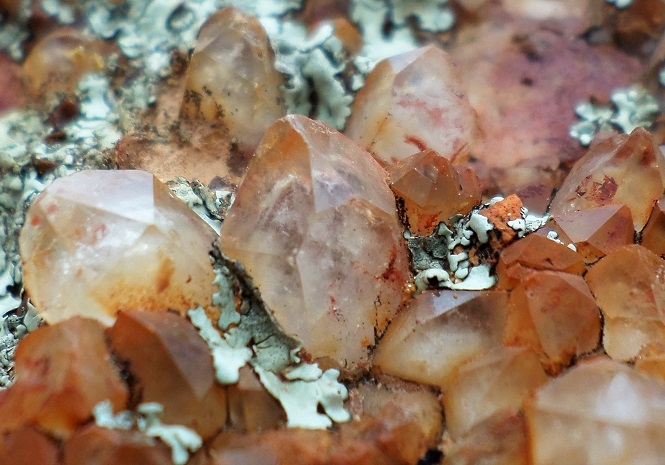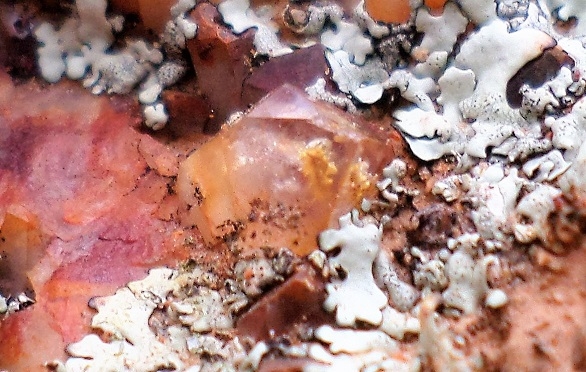-
Posts
456 -
Joined
-
Last visited
Content Type
Forums
Detector Prospector Home
Detector Database
Downloads
Everything posted by DDancer
-
Nice formation there :) I hope it cleans up well for ya and do hope you'll post a pic of then as well. What type of acid do you intend to use? Personally I'd try something mild like CLR first.
-
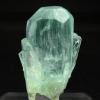
Location Guide For Rock Hounds In The U.S.
DDancer replied to Steve Herschbach's topic in Rocks, Minerals, Gems & Geology
Not a bad guide to getting ya in the general area for a scratch or three Steve. I skimmed it and saved a copy for myself. Thanks. All rock hounding guides are kind of custom pieces in my opinion. This one fills some holes others have left out but it has holes that others include. Many of mine are not in publication anymore but some good ones I have read recently *last few years* that are ok for the south west are the Gem Trails guides. These are state specific, unlike yours which is a good country wide reference, but when in a locality or state its often easier to use this type of guide when planning a fossic :) Cheers! -

Sure Its Quartz But With A Twist
DDancer replied to DDancer's topic in Rocks, Minerals, Gems & Geology
Thanks again :) Jim after reading your adventures I had wondered if you'd found calcite's of interest among the silver in your regions. Fred I'm pretty sure that those spots of interest are still there myself however I'm "geographically challenged" out bush but there is nothing to say an angry wood chuck or goanna might not have moved things around from time to time. Hahh! -

Sure Its Quartz But With A Twist
DDancer replied to DDancer's topic in Rocks, Minerals, Gems & Geology
Thanks :) Actually Lipca when I noticed the phantoms I started looking harder for the best ones when the morning sun hit that bit and stopped me. I know exactly were its at on that plate though. Hahh! And you can see the bit off to the upper left in the close shots of the plate. ;) I still have not even cleaned it and when I do decide to I'll be looking for more. No dolly pot for that if I do. My 7000 didn't register anything and come to think on it I never tried the 2300 I had on hand at the time. Though I did drag both the detectors back around where I thought I picked it up hoping to find more..... sigh. My mistake for not way pointing it. -
Hey all :) I know quartz and quartz crystals are among the most common things one finds while out prospecting. Thing is you never know when you'll get an added treat for bending down and picking up that interesting shiny. I found this last season down under after a good 3 km romp thru the bush. I'd come into an area with a lot of faceted milky quartz and picked up my first lump thinking it'd be a good example of the area. It got heavy so I put it down and decided I'd find a smaller bit. A few dozen meters away a smaller quartzy plate flashed and caught my eye. The clear quartz is very uncommon in the heavy mineral mixes that I was prospecting so into the back pack it went. My booby prize if I didn't hit any gold for the day :) Well I did poke around for a few minutes but didn't find anything else of interest, either detecting or specking, and thought to myself I could find the spot again and maybe give it a better go the next day. I'd not found any gold yet and it was later in the day back near camp *of course* that I finally got a small reward for the walk. So my shiny was now not the booby prize for the day. But little did I know till the next morning when I pulled it out again and gave it a good gander. Looking into the depths I saw that many of the crystals showed Phantoms inside. Phantom crystals are crystals that form twice with the original crystal being covered by the second growth. That had me pretty happy as I've only ever found one other example. While rotating it in the light of morning I caught a flash of Gold! Well I broke out the 10x magnifier and yep, on top of a very small Phantom crystal a small gold crystal had begun to form and over that the second layer of clear quartz. Small stuff, sure, but a fine find for me. Well a long story short~ nope I could not find the spot again after two goes. But hey Quartz with a twist definitely made my day. Thanks for reading
-
Hehh, I remember the Colorado gem shows well as a kid. I'd take about 20lbs of stuff and trade around on the floor. My very first rock, fresh from the backyard, I thought was my Eureka Gold moment! Till dad sat me down and showed me a few things. Still have it~ Chunk of white quartz with big flat golden mica running thru it. Gold and Rocks kinda stuck and I'm still at it :) Out prospecting I'm often picking up and scratching around for rocks more than the gold. I often find it makes for a great day finding a shiny odd rock or two when there's nothing in the pan or I have a pocket full of bullets.
-

Video - GPZ 7000 Settings & Z19 First Look
DDancer replied to Steve Herschbach's topic in Minelab Metal Detectors
I had wondered if Phasetech would be posting that vid here after seeing it the other day. Definitely worth a watch thank you for the production :) -
Be more interested if there was something on the use of terahertz imaging technologies applied to ground searching.
-

Some New Video's The GPZ Warble And 19 Inch In The Field
DDancer replied to DDancer's topic in Minelab Metal Detectors
*nods* Swing does affect the signal, warble, however its one that should not be ignored. It can, and sometimes is, ignored as a hot rock or ground signal under some instances. I know, I've dug them ;) found a few species as a result myself. And I'll grant his signal was shallow in my opinion. There is one more signal that I was not able to successfully record, and I don't subscribe or upload to youtube, and that is the "treble" signal. Maybe I'll find one vid of it. However there is a load of info just in the observations and to that I think we all agree. -
As I occassionaly do on my off days I check around YouTube for new stuff on the Zed. Today was a nice suprise. I want to thank Aussie Bloke and Gold chaser for these new vid's. Aussie Bloke has put out one on my favorite noise The Zed Warble :) Something to pay attention to : And Gold Chaser has a series of video's on the gpz 19". Gotta love calcrete . Hopefully all the video's will play in succession otherwise look it up at youtube. :
-
Love'm when they are in the iron stone ;) But very unusual here in the states. Gotta find your patch ;) hehh
-
Do not take this wrong mate but your dealing apples and oranges messing the 14 with the 19 and I make no bones about it. At that I'm going to point you back to the posts: JP is speaking from experience with the 19 and I am most certainly not. I have also intoned that there will be variance between the two coils just like any other machine. No false thinking there mate. As to pin pointing its a desire I have and something I think, remotely, that the Zed is capable of. You dug a HOLE :)) and got the reward but it was a big arse Hole ;) *I'm betting*. Good on ya though! edit: Great info though and again good on ya!
-
Got to love that warble tone :) Its one of my favorites. Funny enough that tone usually occurs only with large bits or bits with sharp points but it never fails to halt me in my tracks. It does not surprise me in the difference with insitu targets and air targets even if they are on the ground. Seen a lot of foolish arguments in forums over the years about "air testing" so its best just to ignore them. If nuggets were in the air we'd be using butterfly nets to get them not picks and crowbars. Good stuff.
-
Makes good sense to me JP. I am not mistaking your passion nor your advice/instruction or the why's. I witnessed it, the passion, first hand many years ago in Stanton AZ and have never forgotten. I'm the same way in my own profession in aviation so your professionalism, and that of others, are understood and appreciated as are your approaches to the technical details. I do thank you for the debate and your views. Knowledge is indeed power. Hahh! I have used what has been given here and given it a Good Go. So what I'm giving back is just my return on all of our members advise and instruction. Pay back if you will. If I seem argumentative its only in a good way as I see it as debate and really am not looking to win anything but knowledge. This year I put the Zed in with the 2300 myself thinking it would be a good combination. Though its comparing apples to oranges I ended up reselling the 2300 as I found that there was very little that I could do with the 2300 that I could not with the Zed. If ML can ever make a smaller coil, something I'm doubting can be done *kind or like the Garret GTI never being able to come up with a imaging coil smaller than 8 inches*, we will all be talking about another set of tweaks to get the most out of that coil as well. Me I'm considering dragging the 3000 with the Joey and 11 DD back out of retirement for use as a pin pointer with the Zed. That's about all the 2300 was really good for with me aside from being able to push into grass and bushes the 14 inch could not be worked in. Settings aside I have to wonder on the subject of Pin Pointing which is probably the most irritating subject with the Zed in the field. I wonder if it would be possible to get ML to make a Zed set up so that it could operate much like a PI in cancel/mono mode~ ie turn off one of the receive coils and operate similar in manner as is done with DD coils. That function helped me so many times on deep stuff with my 3000 as to be a no brainer for the Zed. Almost every picture I see of deep finds shows a PI in the background and that was so in my experience as well. Having to call a mate over to figure out where the nugget is in the calcrete so we didn't have to blast a hole to find the nugget required a PI. I could find no way to dull the Zed down enough to get accurate pin pointing. You literally have to get the target out of the hole or trench as it were. Funny enough you can tell a Zed hole from a PI hole very easily ;)
-
I expect there is a difference in the way one uses the 14 verses the 19. *shrugs* To be expected. Variance of performance due to coil change out occurs with all detectors. I do not intend to get a 19 but if the opportunity arose I would try one out. With that said I would hope that does not disqualify my observations. The 14 is plenty hot on the Zed for me with my largest find at 32 inches at one ounce and a heap of smaller stuff in extremely well pounded ground. I do understand and respect JP's, and others, position on the use of the Smoothing Filter. I am very aware that it is a filter and as such there is a trade off. Hehh :) If I'm missing much well good for the next guy however I don't expect that I am. Would a 19 inch allow me to keep the filter turned off? Don't know but mayhap one day I'll find out. No excuse but while trying to train my hearing without this filter last year~ and I did~ I ran into the same problem I have with my normal hearing. I find it almost impossible to understand a person speaking to me from more than 2 feet away when there is high ambient noise or white noise. But strangely at night I can hear bats chirp at the camp fire. Further more I found that I had to dull the Zed down so much that I was missing quite a bit of small stuff. My partner last year amply proved it as he ran extremely hot settings and no smoothing. The man has years more experience detecting and his hearing, and ability to train it, is much better. So for me using the filter led me to the settings that I use and observations that I have made here as well as allowing me to come on par with my partner in many respects last year. No excuses here just to each his own I reckon as it appears Norvic, for one, has great results without smoothing but similar settings. I do explain audio smoothing to the few I have instructed on the use of their Zeds and it includes the caveat : This is a filter try to use the machine without it on. Breaks in my threshold give me pause as well and often with good result. Breaks in threshold are something most anyone who has been detecting for years will appreciate regardless of the type of machine used. I wont say I get the breaks you are JP however when they occur I look into them just like you do ;). I do not qualify myself as a professional~ just an experienced Joe Shmoe who enjoys a good prospect and sharing with like minded people. Understanding ZVT seems to boil down to effective utilization of your comment JP: In PI's its timing and sensitivity. In ZVT its about the noise. Yes? No?
-
Norvic, I really don't know if its a variance of machine~ mine is a pre-production one, machine set up~ I use the stock headphones~ or our native hearing. Then there is the good old comfort zone. Higher thresholds do cut back signal recognition for me as well. Note that JP refers to the ground stutter he recognizes with his set ups~ for me with smoothing on and lower thresholds I hear similar patterns. With smoothing off its just more recognizable but harder for me to process as the noise environment increases dramatically. JP points out the interaction between three of the 4 settings I mess with most but does not address Volume Limit. While he is speaking of the 19 inch coil similar methodology appears to be being used for increases in target recognition I feel that occurs regardless of the coil size. ZVT is reading a window of noise where sensitivity falls behind volume and threshold limits that improve target recognition. Thanks JP and sorry if you or anyone else feels I'm taking you out of context. Vanursepaul, I'll be interested to know if your tweaking improves things for you :)
-
I have to make an amendment to what I've said. On reviewing my settings notes I have made a small misnomer on what I call Target Volume in the previous post. To me Target Volume is not one setting, Volume, but 2 settings: Volume and Volume Limit. My apologies. To be clear adjustments in Volume Limit have a strong effect on volume of a target. Limit adjusts the cut off point of all targets much like threshold based on strength of signal; this adjustment also increases ground noise at higher levels. Small targets light up louder at higher limits in my observation. Adjustment to Volume goes down a notch for various increases in Volume Limit. Touches to the Threshold occur next. Sensitivity is then adjusted for stability. For each location I go to my first few small targets are used for tweaking to that locality then I just move along in a stable configuration for the rest of my stay. In areas with large variations of ground noise, Lake Austin mainland is a good example, I will work out where the big changes are and schedule them like a new area while sticking to the settings for areas I can work. Tortuga my actual settings generally start out thus: Volume 10, Volume Limit 16-18, Threshold 10, Sensitivity 17-19. That usually in High Yield/Difficult *Australia conditions* with low smoothing turned on after I have made a few small tweaks to Volume limit and sensitivity for environmental noise with smoothing off. I get a stable operation then I find my targets to tweak on. When I'm in an area I know nothing about and on walk about I set up in General/difficult instead. To be fair this last year I worked more in General than High Yield. My sensitivity 16-20, bad ground 8-15 Volume 10-15, bad ground 6-10 Threshold 3-10, bad ground 10-15 Volume limit 15-18, bad ground 6-14 Addressing the topic its my opinion that ZVT as explained detects targets in the transition state between field polarity shifts. Adjustments that I've put forward in effect are what I feel as best to get the most response from target signals as I am looking for the best window between the field shifts for detector response. Sensitivity, while important, does not really affect that window of detection. How loud the window is and its cut offs define the frame of the window and how much the detector can see out the window. In my opinion because ZVT does not operate on a conventional PI base window of send and listen ( a sensitivity based system) but on a basis of continuous read looking for the best view does get better results with lower sensitivities. Again thanks for reading.
-
Always nice to scratch an itch :)
-
I find it kind of funny myself that its taken this long for this kind of info to have come up in topic. In 2015 I made the same observation with Target Volume and sensitivity. Combined with Threshold it really kicks target id up a notch especially with depth on small stuff~ .5 grams or less~ however it does lend to higher incidents of the howlies in salt and high iron grounds. Backing off sensitivity does not overly effect any change in high saturation grounds but Target volume and Threshold do. Part of the combination I learned only this year by swapping info with another (read on). I only ever shared the observation with a few others and it generally fell on deaf ears at the caravan parks. However with novices to the Zed I do share the info as I set them up ~ pitty I never get any feed back there :( as they are pretty much one time events. This pretty much why I've never really talked about settings here. I also figured others knew but kept it under wraps as its hard to demonstrate easily. Something that comes with experience. That said I did have one success in passing the information, even got feed back when I met the guy again at the same park, this last season *2016*. His issue was a bit different though. Seems he had purchased one of the first batch of Zeds that came out and was impressed with its sensitivity to his pick among other things. He'd damaged his Zed and sent it back to have it replaced by another unit~ standard operating procedure by ML and one I disagree with~ only to find the new unit did not perform like the original~ could not hear his pick. Apparently he made some video with his new unit and a friends original unit and sent the complaint in to his dealer along with the replacement unit. Got another new unit and same results. Another complaint and another unit and again same result. When I met him he had his latest unit and while we talked he was about to scrap it as well thats when I shared my settings and information. Couple of weeks later we met again and he was most pleased. The new unit now worked like the original and I even learned a bit as we traded observations on combinations of Target Volume, Threshold and Sensitivity. As to his original machine I suspect he messed with the settings initially but forgot them and for whatever reason he and his friend did not set their units up exactly when they made the complaint video but that's my thought. Thanks for reading. DD
-

Amateur Detectorist Finds 15th Century Ring
DDancer replied to Steve Herschbach's topic in Metal Detecting For Jewelry
Hehh, for whatever reason that got lost in the reading for me Steve. Thanks. Think I was just stuck on looking at the ring. Good point GB. -

Amateur Detectorist Finds 15th Century Ring
DDancer replied to Steve Herschbach's topic in Metal Detecting For Jewelry
Curiously beautiful ring :) I thought that such items were to be turned over to the British Museum for a finders fee? -

Minelab Files Suit Against XP Metal Detectors
DDancer replied to Steve Herschbach's topic in Minelab Metal Detectors
Interesting. Without knowing much about what is being infringed apon I can only make the assumption that the patent made by ML is probably to broad. There are a lot of patents out there that stifle development by other companies and individuals because they are so broad as to effectively kill innovation. Granted such broad applications of patent can help against patent trolls, which are a big problem to producers and innovators as well, but for a company to "troll" on the competition is just as bad in my thought. A good example of broad patent fighting can be found if one looks at the history of aviation. The Wright Brothers patented the physics behind aircraft control~ control of Yaw, Pitch and Roll~ and spent many years in court trying to make money off of something that was not expressly theirs to own thru patenting. In this digital age such broad applications to data storage, as pointed out in the article, should be pretty specific and unique in their design and patent. I have a feeling that is not the case with the fight on this property between ML and XP. My thoughts. -
Everything is better with butter right? ;) Would have made more impact with a slab of Bacon in the picture for me though! Hahh!
-
The only way to know the true purity of ones gold that I know of is with an assay. Granted your destroying nuggets in assay so its a personal call when grading raw gold when you go to sell or buy them. XRF devices only scan a very shallow specimen, few microns deep, for the spectroscopic sample that they read however its very accurate and indicative of the overall mixture of the gold. Scratch testing, though invasive, is also a shallow test and the regents used have a wide margin of error. Specific gravity tests have a wide margin of tolerance as well making them pretty much impossible to calculate all the materials in the specimen being measured for purity. That being said knowledge of the geography of where a particular nugget was found helps with grading the purity. Here in America and in Australia, as well as other parts of the world, local knowledge combined with testing are ones best bet for a reasonable grading of raw gold. For myself experience over the years usually leads me to talk to the locals about relative grade of raw gold for any area that I've visited. They, the locals, have general knowledge as there is always one or more of them who have assayed their gold at one time or another~ so I don't have to destroy my nuggets to feel good about their grade myself. My thoughts.

.jpg.e8512ac34a0c5a0c16c1a8045eda8a26.jpg)
